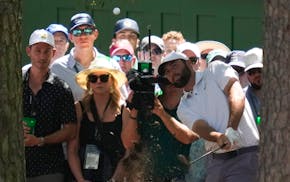Carlos Gomez took a rip at a Mariano Rivera fastball in the bottom of the ninth inning Friday, looked down and realized most of his bat had evaporated, leaving him with a shard of handle the size of a piccolo. Gomez then struck out, finishing an 0-for-5 night, and the Twins lost to the Yankees, 6-5.
What matters more in the context of the endless season is that the Twins have settled on a top-of-the-order combination that could make fans intent on catching the first inning of every game the rest of the year.
When the Twins returned to relevance early this decade, they did so with a young, athletic group of players. Their speed on the bases and in the field helped offset their lack of power.
As the decade progressed and players such as Doug Mientkiewicz and Luis Rivas were winnowed from the roster, a new group of core players began rising through the system, promising to transform the lineup into an intimidating group of sluggers.
That transformation never occurred. Justin Morneau remains the Twins' only true power hitter, and even he keeps his average healthy by delivering opposite-field singles. To date, Michael Cuddyer, Jason Kubel, Delmon Young and Joe Mauer have failed to produce the kind of power that would alter the Twins' reputation as a slap-hitting team relying on pitching and fielding.
While the shift to power has stalled, the Twins, to conform to manager Ron Gardenhire's ideal, have already begun transitioning back to youth, speed and fielding. In the post-steroid era, youth, speed and fielding might be the way to go.
Gomez is the Twins' most exciting player since the young Kirby Puckett. Alexi Casilla, called up because of injuries to Adam Everett, Nick Punto and Matt Tolbert, is the prototypical Twins second baseman -- a speed player with excellent range, a strong arm and the ability to bunt.
Gomez and Casilla will make mistakes of youth and exuberance. They are also capable of making this a dynamic lineup in the spirit of the mid-'80s St. Louis Cardinals.
With Gomez and Casilla running the bases in front of Mauer and Morneau, the Twins now look like those Cardinals, whose lineup started with Vince Coleman, Willie McGee, Tommy Herr and Jack Clark.
Coleman, like Gomez, was perhaps the fastest player in the game. Casilla has far to go to be compared to McGee, but he is a switch-hitter with speed. Herr, like Mauer, produced runs by putting the ball in play with speed on the bases, and by acting more like a third leadoff hitter than a true No. 3 batter. Clark, like Morneau, was his team's only legitimate power hitter.
If Tolbert, another speed player, had stayed healthy, he would be playing every day. Without injuries, the Twins' starting infield on any given day would feature Tolbert, Casilla and Nick Punto in the lineup, with Brendan Harris and Mike Lamb taking lesser roles.
Combine that new, agile, infield with Gomez in center, and this team would be vastly improved in the field and on the bases. It might score more runs, too, because there is no reason to play station-to-station if you don't hit home runs.
Baseball's biggest disappointments this year -- the Yankees, Tigers, Indians, Mariners, Mets, Brewers, Reds and Rockies -- are power teams failing to hit enough home runs to obscure their flaws.
In the post-steroid era of baseball, speed, fielding range and baserunning will acquire increased importance. Twins executive Mike Radcliff offered that rationale when defending the Johan Santana trade, noting that Gomez is one of the fastest players in baseball and could become one of the most dynamic all-around players in a sport that will no longer be ruled by power.
Even if building a lineup around speed isn't optimal, it's not like the Twins have much choice.
Jim Souhan can be heard Sundays from 10 a.m.-noon on AM-1500 KSTP. jsouhan@startribune.com

Souhan: Why Tiger Woods should keep swinging
Souhan: Scheffler wins Masters again, shows what makes him special
Morikawa falters in final round at Masters

Keeping up with the Joneses who helped design Augusta National's classic back nine

